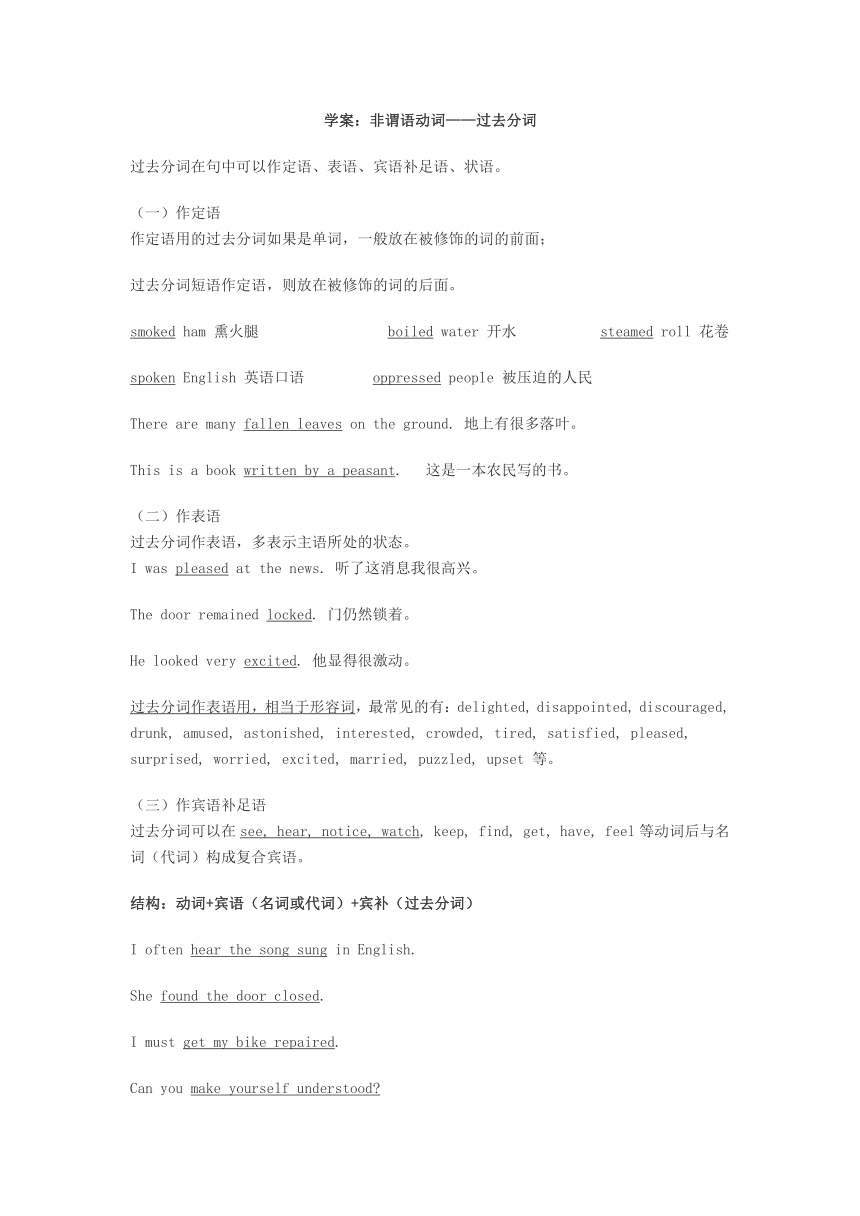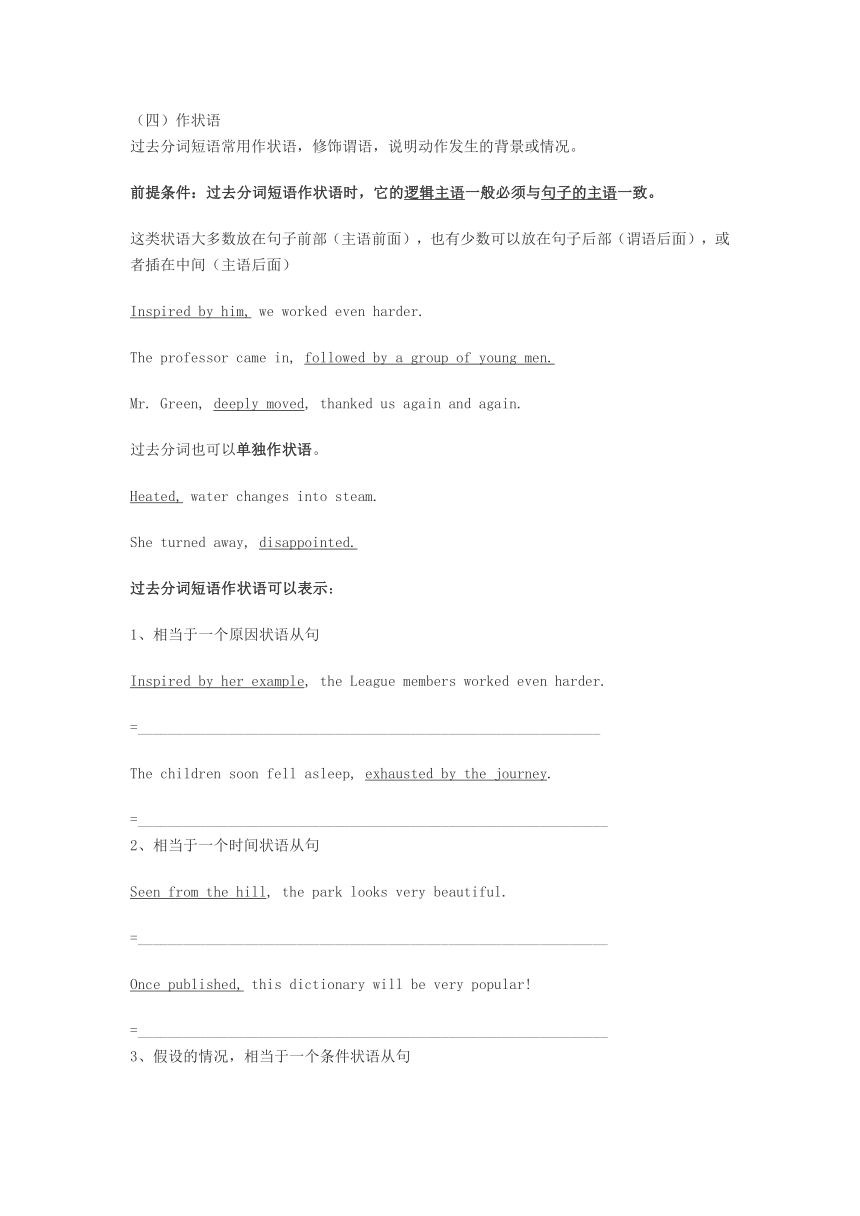江苏省某市重点中学高二英语导学案:M5U3 grammar(牛津译林版)
文档属性
| 名称 | 江苏省某市重点中学高二英语导学案:M5U3 grammar(牛津译林版) |  | |
| 格式 | zip | ||
| 文件大小 | 12.7KB | ||
| 资源类型 | 教案 | ||
| 版本资源 | 牛津译林版 | ||
| 科目 | 英语 | ||
| 更新时间 | 2012-08-27 20:59:26 | ||
图片预览


文档简介
学案:非谓语动词——过去分词
过去分词在句中可以作定语、表语、宾语补足语、状语。
(一)作定语
作定语用的过去分词如果是单词,一般放在被修饰的词的前面;
过去分词短语作定语,则放在被修饰的词的后面。
smoked ham 熏火腿 boiled water 开水 steamed roll 花卷
spoken English 英语口语 oppressed people 被压迫的人民
There are many fallen leaves on the ground. 地上有很多落叶。
This is a book written by a peasant. 这是一本农民写的书。
(二)作表语
过去分词作表语,多表示主语所处的状态。
I was pleased at the news. 听了这消息我很高兴。
The door remained locked. 门仍然锁着。
He looked very excited. 他显得很激动。
过去分词作表语用,相当于形容词,最常见的有:delighted, disappointed, discouraged, drunk, amused, astonished, interested, crowded, tired, satisfied, pleased, surprised, worried, excited, married, puzzled, upset 等。
(三)作宾语补足语
过去分词可以在see, hear, notice, watch, keep, find, get, have, feel等动词后与名词(代词)构成复合宾语。
结构:动词+宾语(名词或代词)+宾补(过去分词)
I often hear the song sung in English.
She found the door closed.
I must get my bike repaired.
Can you make yourself understood
(四)作状语
过去分词短语常用作状语,修饰谓语,说明动作发生的背景或情况。
前提条件:过去分词短语作状语时,它的逻辑主语一般必须与句子的主语一致。
这类状语大多数放在句子前部(主语前面),也有少数可以放在句子后部(谓语后面),或者插在中间(主语后面)
Inspired by him, we worked even harder.
The professor came in, followed by a group of young men.
Mr. Green, deeply moved, thanked us again and again.
过去分词也可以单独作状语。
Heated, water changes into steam.
She turned away, disappointed.
过去分词短语作状语可以表示:
1、相当于一个原因状语从句
Inspired by her example, the League members worked even harder.
=_____________________________________________________________
The children soon fell asleep, exhausted by the journey.
=______________________________________________________________
2、相当于一个时间状语从句
Seen from the hill, the park looks very beautiful.
=______________________________________________________________
Once published, this dictionary will be very popular!
=______________________________________________________________
3、假设的情况,相当于一个条件状语从句
United, we stand; divided, we fall.
=______________________________________________________________
Given more time, we could do it much better.
=______________________________________________________________
4、相当于一个让步状语从句
Beaten by the opposite team, the players were not discouraged and practiced even harder.
=______________________________________________________________
这类状语多数放在句子前面,个别放在主谓之间。
5、伴随情况(这种用法没有与之相当的状语从句可以代替)
He came back, completely tired.
The woman scientist entered the lab, followed by her assistants.
注意:正如前所述:过去分词短语作状语时,它的逻辑主语一般必须与句子的主语一致。
但有时它也可以有自己独立的逻辑主语,这种结构称为独立(主格)结构。多数情况下它表示一种伴随动作或情况。
The boy rushed into the classroom, his face covered with sweat.(=… and his face was covered with sweat.)
All things considered, your article is of greater value than hers.
现在分词与过去分词的区别
(一)现在分词与过去分词在语态和时间关系上的区别
1、语态上的不同
现在分词表示_________的意思,而过去分词表示___________的意思。
例1:The exploiting classes I heard someone opening the door.
The exploited class I heard the door opened.
观察:the fallen leaves, the risen sun, the exploded bomb, faded roses, retired workers, returned students.
这些过去分词用法和例1中的例子表示的意义一样吗?注意观察过去分词动词的词性!那么它们表示:__________
2、时间关系上的不同
观察下列四组:
the changing world boiling water
the changed world. boiled water
developing countries the rising sun
developed countries the risen sun
总结:一般说来,现在分词所表示的动作往往________________,而过去分词所表示的动作往往_________________。
(二)现在分词与过去分词作宾语补足语的区别
例子:I found them painting the windows.
I found the windows painted.
结论:现在分词与句子中的宾语是______关系,它表示的动作往往______________。过去分词与宾语是________关系,它所表示的动作往往______________。
(三)作定语的区别
一般说来,现在分词修饰事物,常与非人称主语连用;而过去分词修饰人,常与人称主语连用。
常见的分词amazed/amazing; excited/exciting; bored/boring; annoyed/annoying; interested/interesting; pleased/pleasing; tired/tiring; surprised/surprising; worried/worrying; satisfied/satisfying; amused/amusing
过去分词在句中可以作定语、表语、宾语补足语、状语。
(一)作定语
作定语用的过去分词如果是单词,一般放在被修饰的词的前面;
过去分词短语作定语,则放在被修饰的词的后面。
smoked ham 熏火腿 boiled water 开水 steamed roll 花卷
spoken English 英语口语 oppressed people 被压迫的人民
There are many fallen leaves on the ground. 地上有很多落叶。
This is a book written by a peasant. 这是一本农民写的书。
(二)作表语
过去分词作表语,多表示主语所处的状态。
I was pleased at the news. 听了这消息我很高兴。
The door remained locked. 门仍然锁着。
He looked very excited. 他显得很激动。
过去分词作表语用,相当于形容词,最常见的有:delighted, disappointed, discouraged, drunk, amused, astonished, interested, crowded, tired, satisfied, pleased, surprised, worried, excited, married, puzzled, upset 等。
(三)作宾语补足语
过去分词可以在see, hear, notice, watch, keep, find, get, have, feel等动词后与名词(代词)构成复合宾语。
结构:动词+宾语(名词或代词)+宾补(过去分词)
I often hear the song sung in English.
She found the door closed.
I must get my bike repaired.
Can you make yourself understood
(四)作状语
过去分词短语常用作状语,修饰谓语,说明动作发生的背景或情况。
前提条件:过去分词短语作状语时,它的逻辑主语一般必须与句子的主语一致。
这类状语大多数放在句子前部(主语前面),也有少数可以放在句子后部(谓语后面),或者插在中间(主语后面)
Inspired by him, we worked even harder.
The professor came in, followed by a group of young men.
Mr. Green, deeply moved, thanked us again and again.
过去分词也可以单独作状语。
Heated, water changes into steam.
She turned away, disappointed.
过去分词短语作状语可以表示:
1、相当于一个原因状语从句
Inspired by her example, the League members worked even harder.
=_____________________________________________________________
The children soon fell asleep, exhausted by the journey.
=______________________________________________________________
2、相当于一个时间状语从句
Seen from the hill, the park looks very beautiful.
=______________________________________________________________
Once published, this dictionary will be very popular!
=______________________________________________________________
3、假设的情况,相当于一个条件状语从句
United, we stand; divided, we fall.
=______________________________________________________________
Given more time, we could do it much better.
=______________________________________________________________
4、相当于一个让步状语从句
Beaten by the opposite team, the players were not discouraged and practiced even harder.
=______________________________________________________________
这类状语多数放在句子前面,个别放在主谓之间。
5、伴随情况(这种用法没有与之相当的状语从句可以代替)
He came back, completely tired.
The woman scientist entered the lab, followed by her assistants.
注意:正如前所述:过去分词短语作状语时,它的逻辑主语一般必须与句子的主语一致。
但有时它也可以有自己独立的逻辑主语,这种结构称为独立(主格)结构。多数情况下它表示一种伴随动作或情况。
The boy rushed into the classroom, his face covered with sweat.(=… and his face was covered with sweat.)
All things considered, your article is of greater value than hers.
现在分词与过去分词的区别
(一)现在分词与过去分词在语态和时间关系上的区别
1、语态上的不同
现在分词表示_________的意思,而过去分词表示___________的意思。
例1:The exploiting classes I heard someone opening the door.
The exploited class I heard the door opened.
观察:the fallen leaves, the risen sun, the exploded bomb, faded roses, retired workers, returned students.
这些过去分词用法和例1中的例子表示的意义一样吗?注意观察过去分词动词的词性!那么它们表示:__________
2、时间关系上的不同
观察下列四组:
the changing world boiling water
the changed world. boiled water
developing countries the rising sun
developed countries the risen sun
总结:一般说来,现在分词所表示的动作往往________________,而过去分词所表示的动作往往_________________。
(二)现在分词与过去分词作宾语补足语的区别
例子:I found them painting the windows.
I found the windows painted.
结论:现在分词与句子中的宾语是______关系,它表示的动作往往______________。过去分词与宾语是________关系,它所表示的动作往往______________。
(三)作定语的区别
一般说来,现在分词修饰事物,常与非人称主语连用;而过去分词修饰人,常与人称主语连用。
常见的分词amazed/amazing; excited/exciting; bored/boring; annoyed/annoying; interested/interesting; pleased/pleasing; tired/tiring; surprised/surprising; worried/worrying; satisfied/satisfying; amused/amusing
